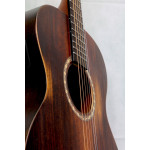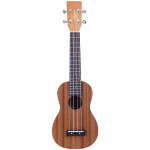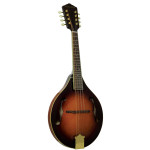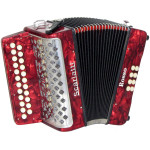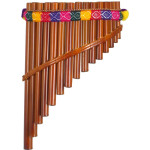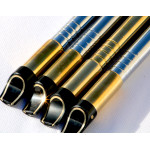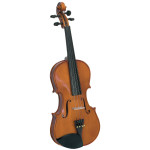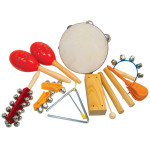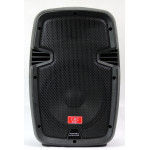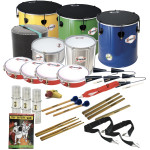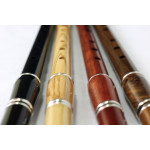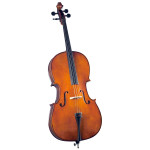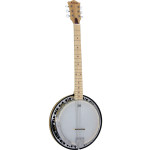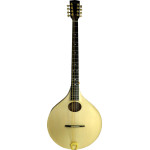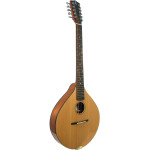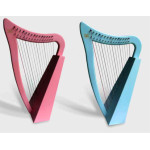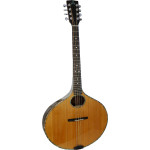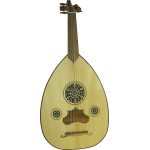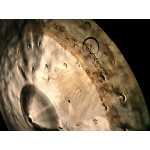Glossary of Folk Musical Instruments & Styles from Around the World
This list is based on information originally compiled by ARC music, and has been extensively revised, extended and developed for the internet by Pete McClelland at Hobgoblin Music.
Accordion: Free reed instrument with a keyboard originating in Saxony and Bohemia, now common throughout the world in folk music. Various types include piano and button keyboards, and chromatic and diatonic tunings.
Agogo: Two wooden or metal tubes or blocks on a wooden or metal frame, one larger and lower pitched than the other. hit with sticks.
Alboka: A double clarinet of Basque Country. There are some similar instruments in North Africa. It has a double tube with a horn end. It is played with a continuous respiration technique. It has only one non-complete scale.
Angklung: Bamboo bells native to Indonesia. Each Angklung consists of two or three bamboo tubes of differing lengths tuned in octaves.
Anglo Concertina: See Concertina
Antara: term used by the Quechua people of Peru for the Andean panpipes (of clay).
Appalachian Dulcimer: Name applied to certain musical instruments of the box zither type. Includes Hammered Dulcimer and Appalachian Dulcimer.
Atabal: cylindrical double-headed bass drum of the Basque region; wider than tall.
Atabaque: general term for a conical single-headed drum of Brazil; usually played in threes, each of different size.
Aud: See Ud
Autoharp: Zither with a keyboard chord making mechanism which mutes unwanted strings. Strummed or Picked.
Baglama: long-necked turkish lute, about 1m, member of the saz family. Also used in Greece.
Bagpipe: reed instrument with an air reservoir in an animal skin bag. Common across Europe and Arabic countries. See Gaida, Gaita, Biniou, Union, Uilleann, Northumbrian, Piob Mhor, Scottish smallpipes, Dudelsack, Zampogna, Cornemuse, Musette, Cabrette, Cimpoi.
Bajo Sexto: Bajo Sexto is the bass instrument used in Norteno and Tex-Mex music.
Balafon: West African xylophone: set of three: bass, mid range and high one for soloing.
Balalaika: Lute-type; triangle shape; national instrument of Russia. Really a family of instruments, including Piccolo, Prima, Secunda, Alto, Bass and Contra-bass.
Bamboo Xylophone: pair of large bamboo xylophones erected on ladders, beaten with rubber flipflops (sandals) or thongs.
Bandir: or Bendir; North African tambourine, round wooden 40 or 59 cm across, with two strings stretched under its skin to produce a buzzing sound, Morroco, Algeria, Tunisia.
Bandola: modern lute of Colombia; tear-drop shape, flat or concave back.
Bandoneon: square-built button accordion; used in Argentinian tango.
Bandura: type of psaltery found in the Ukraine; short neck, oval, flat body; held vertically.
Bandurria: Small 12 string mandolin type instrument with a very short wide neck, popular in Spain.
Banjo: American development of African origins (related to the Kora etc., but with a guitar type neck). Found with 4, 5, 6, 7 and 8 or more strings, popular types are the 5 string, Tenor (4 string), Plectrum (long neck 4 string), Banjolele (Ukulele Banjo), Banjolin (Mandolin Banjo).
Barbat: Iranian name for the Ud
Bass Guitar: A large guitar tuned one octave below the bottom four strings of a normal guitar.
Bata (African): set of three drums: the 'iyailu' or "mother drum", a talking drum; the 'emele abo' is the second drum, smaller and higher pitched; the 'omele' is the base of the set and consists of 3 or 4 small drums tied together.
Bata Drums: set of three double-headed religious drums used in Cuba. The Iya, Itotele and Okonkolo.
Bawoo: Chinese wind instrument; bamboo tube with rectangular hole carved in side near closed end, with reed fastened across; finger and thumb holes.
Bayan: chromatic accordian of Russia and Belorussia, with button keyboard.
Bena: a single string bowed ancient folk instrument found in Tista_Dharla river basin of Bangladesh. Used as accompaniment for local "Kushan" folk theatre.
Berimbau: The berimbau consist of a wooden stick which is strung with a steel string to form the bow shape, a gourd with an opening on one side which acts as a resonator, a coin or stone, a thin bamboo stick, and is played with a basket shaker called caxixi.
Biniou: Breton bagpipe with single drone, pitched an octave higher than usual.
Birbyne: Lithuanian wind instrument, soft sound, clarinet type. Played in ensembles and solo.
Bodhrán: Single-headed frame drum of Ireland; membrane, of animal skin, usually nailed to frame; hand-held using criss-cross system of cord, wire or sticks over open end.
Bomba: Drums used for Bomba music in Puerto Rico, Ecuador and probably other areas with African traditions. In Puerto Rico there are two drums played together for the Bomba, the Buleador(bass) and the Subidor or Primo (lead)
Bombanshi: The Bombashi is a fipple flute found in Tista_Dharla river basin of Bangladesh. This special type of flute is a necessary accompaniment for a local folk theatre “Poddopuran”. It is made of bamboo, having seven playing holes.
Bombarde: Breton shawm, usually pitched in Bb, sometimes C. Traditionally played as a duet with the Biniou.
Bombashi: a fipple flute found in Tista_Dharla river basin of Bangladesh. Used as accompaniment for "Poddopuran" folk theatre. It is made of bamboo, with seven finger holes. **
Bombo: large sheepskin drum. from Spain and South America. The latin American type is made from a hollowed tree, and played with a stick and a mallet.
Bones: a pair of cows ribs rattled together in the hand. Also often made of wood or other bone material. Traditional in Britain and Ireland.
Bongos: Two small drums, one larger (and lower pitched, usually by about a fifth) than the other which are held between the knees and played with both hands. Traced back to Cuba in the late 1800s, and probably originating from Africa.
Bouzouki: Greek long necked lute related to the Turkish Saz; 3 or 4 double courses of metal strings. Adopted by Irish musicians more recently.
Bowed Psaltery: Box zither; A 20th Century (probably) adaptation of the psaltery in a triangular shape allowing for bowing on alternate sides. Other psalteries are usually plucked.
Bucium: Romanian Alphorn
Buhai: Romanian drum-like instrument with a rope running through the drumhead. The vibration as the rope is pulled produces a low bass note. It is used in the traditional Christmas caroling groups called "colinde".
Buleador: Bass drum used for Bomba music in Puerto Rico.
Cabasa: South American rattle. Made from a metal cylinder with metal beads around it which are scraped against it. Related to African gourd rattles with beads.
Cabrette: French bagpipe
Caixa: Samba drums from Brazil, usually with metal body approx 12" head. Caixa Tarol is shallowest, Caixa Malacacheta next and the Repinique is the biggest.
Caja: Frame drum, sometimes with snare, of Spain and the New World.
Cajon: Cuban box drum, made from a wooden box.
Calabash: dried hollow shell of a gourd, used as a rattle.
Campana: Bell.
Castanets: A pair of wooden cupped blocks held in one hand, used for flamenco dance in the Seville tradition.
Castanuela: Castanets in English. A pair of bowl shaped pieces of wood (usually grenadilla now, but originally stone or shell) connected by a cord, held in the palm of the hand. From Spain.
Cavaquinho: Cavaquinho - a small 4 string Portuguese guitar family instrument well known in Brazil (also known as Cavaco) where it is used in Choro and Samba music. was exported by the Portuguese across the world including to Hawaii, where it developed into the ukelele. Commonly tuned D,G,B,D but other tunings are used.
Celtic Harp: Small instrument of 24 to 34 strings around 1m tall, with curved neck and pillar. The sound box was once carved from solid, but now is usually a box.
Chalumeau: Single-tube, cylindrical, single reed instrument. A seventeenth century ancestor of the clarinet, it has a recorder type body with a single reed mouthpiece. Similar folk instruments are found in many Arabic and European cultures; see Albogue, Alboka, Diplica, Hornpipe, pibgorn, and Sipsi.
Charango: Ten string instrument, made from the shell of an armadillo; an Amerindian version of the imported European mandolin; found in Andean region.
Cheng (1): Half tube plucked zither of the Han chinese.
Cheng (2): Chinese gong.
Chepkong: Kenyan six string pentatonic Lyre. See Kipukandet
Chonguri: Georgian fretless long neck bowl back lute. Three strings from the peg head and a banjo-like 4th string peg halfway up the neck.
Choquella: predecessor of the kena, but bigger.
Chordophone: class of instruments comprising strings stretched between fixed points, including: zithers, lute types (lute, violin, guitar, etc), harp types
Cimpoi: Romanian Bagpipe, usually with a single drone.
Cittern: small flat backed wire-strung plucked instrument; played with a plectrum; popular from renaissance to baroque times. Modern citterns are much bigger, and more like mandolins in shape. Usually with 10 strings in 5 courses. Related to Portuguese Guitarra.
Clarsach: Scottish folk harp, 25 to 34 strings usually. See Celtic Harp
Claves: A pair of round sticks usually of hardwood, played by banging them together. Latin American instrument.
Cobza: short-necked lute of Romania; pear-shaped with 8 to 12 strings, 5-7-sectioned resonator.
Concertina: Small free reed instrument from England, usually hexagonal in shape. there are three common keyboard layouts, each completely different to play on. Anglo, English and Duet (McCann, Crane, Jeffries and Hayden are all types of duet).
Congas: The Congas are a tall pair of wooden framed hand drums also known in Cuba as Tumbadora.
Cornemuse: French mouth blown bagpipe with chanter and small drone in one stock, and a separate large drone.
Crwth: a Welsh bowed instrument with a rectangular box shaped body and a violin neck. The bridge stands with one foot on the front and the other foot passing through the soundhole and resting on the back.
Cuatro: of the guitar family; found in South America and the West Indies. The Venezualan Cuatro has 4 strings, looks like a ukelele. The Puerto Rican Cuatro has 10 strings and looks more like a Cuban Tres.
Cuatro De Puerto Rico: Of the guitar family; found in South America and the West Indies. The Venezuelan Cuatro has 4 strings, looks like a ukelele. The Puerto Rican Cuatro has 10 strings and looks more like a Cuban Tres.
Cuica: Brazilian friction drum with a remarkable pitch range.
Cura: smallest of the saz family, about 75cm. See Saz
Cymbala: A modern small trapezium shaped plucked zither, designed for use by children.
Cymbalom: Box zither of Hungary, related to earlier hammered folk zithers. See Hammered Dulcimer
Daduk: Bulgarian fipple flute / Armenian double reed pipe. See Duduk
Dafe: Arabic Frame drum, sometimes has metal rings inside to make a jingle effect. Also known as Duf, and Daf (in Iran).
Daire: round, single-headed drum of south-eastern Europe, Asia etc.
Darabuka: One-sided hourglass-shaped drum; Northern Africa, Middle East
Derbacki: hand drum.
Dholak: (or Dhol) double ended drum traditionally used in weddings across the Indian subcontinent. See Dohol (Iranian)
Didgeridoo: traditionally used by aboriginal people of Northern Australia; an end-blown, straight, natural trumpet, without separate mouthpiece, made from termite hollowed eucalyptus branch, stripped of its outer bark, with beeswax at mouth end.
Didjeridoo: traditionally used by aborigines of Northern Australia; an end-blown, straight, natural trumpet, without separate mouthpiece, made from termite hollowed eucalyptus branch, stripped of its outer bark, with beeswax at mouth end.
Divan: largest member of the saz family, about 140cm. See Saz
Dizi: transverse flute of the Han Chinese.
Djembe: One-sided mushroom-shaped drum from west coast of Africa.
Do-Table: Iranian/Kurdish pair of brass drums, played with leather straps. Related to the Indian Tabla.
Dobro or Spider Bridge Resonator Guitar: Usually a wooden bodied guitar with a single cone resonator. See Resonator Guitar
Dohol (Iranian): Iranian/Kurdish double ended drum played with sticks, used in ceremonies. See Dholak
Dohollah: the brass Tabla. See Tabla
Dolzaina: Spanish double reed instrument, also known as Gralla See Gralla
Domra: Russian and Ukranian lute with a rounded pear shaped body and a bowl back. Three stringed usually but four stings are preferred in Ukraine. Domras come in several sizes, Piccolo, Primo (normal), Alto, Tenor and Bass (and occasionally Contrabass).
Dotar: Iranian two stringed long neck lute related to the Tanbur. Similar construction to the Turkish Saz. See Saz
Dotra: a four string instrument found in the Northern part of Bangladesh. It is the main accompaniment of "Vaoaiya" the mainstream folk song of Northern Bangladesh. Played with a small wooden peg. related to the Sorod or Sarod. See Sarod
Drimba: Romanian instrument essentially same as the jew's harp, or mouth harp.
Dudelsack: German Bagpipe
Duduk: 1) Fipple flute of Bulgaria; 20-100cm long; 6 finger holes. (Also known in Armenia under a different name.) 2) The national instrument of Armenia, a double-reed pipe 40 cm long, with a 9 cm long reed. Also known as Daduk.
Dudy: Czech Bagpipe, made from a goat.
Duet Concetina: See Concertina
Duf: A Mazhar but without the cymbals. Also known as Dafe in Egypt.
Dulcimer: name applied to certain musical instruments of the box zither type. Includes Hammered Dulcimer and Appalachian Dulcimer.
Dumbeck: small brass drum from Pakistan, similar to Turkish darabuka and Iranian Tonbak.
Dumbeg: (or Dumbeck) hour glass-shaped drum similar to darabuka.
Dumbra: lute of the Tartar people.
Dundun: African; set of 4 drums, the 'iyailu' member is shaped like an hour glass and has a skin on each side, linked by tension strings (by pressing these, up to 2 octaves can be played); but only played one-sided.
Dvoyanka: Bulgarian double fipple flute.
Ektara: A North Indian single string instrument often home-made and with an animal skin on a gourd body and one long neck or sometimes two necks. The two part neck is squeezed to vary the pitch. See Gopichand
Electric Guitar: Guitar usually with a solid body and one or more electro-magnetic pickups. Dates back to the 1930s
Emele Abo: See Bata drums
English Concertina: See Concertina
English Guitar: A cittern popular in the 18th century, 10 strings, fan tuners, curved fingerboard. Almost identical to the Portuguese Guitar.
Epinette Des Vosges: French instrument of the dulcimer family, oblong often with 7 strings, 3 of which are fretted. For more info: Visit Christophe Toussaint's Site (en Francais)
Erhu: Chinese 2 string fiddle, with a small, usually hexagonal or octagonal body, dates back to 1100AD.
Fa'Atete: Tahitian drum, covered in a tight, single membrane; distinst, high sound like a drum roll.
Fiddle: English name for the Violin, originated from the Latin Vitula via Norse and Germanic versions. The French words Vielle and later Viol and Spanish Vihuela are also from the same Latin root.
Fife: A small transverse flute used by the military since the 16th century. Plays an octave higher than a flute,
Fipple: a word meaning the sharp edge of the lip (of a flute or recorder).
Fiscorn: Catalan brass instrument used in Cobla groups. similar to a Fluegelhorn.
Flabiol: Catalan tabor pipe with at least 5 holes. Played with one hand, the other hand beats the Tambori (tabor).
Flageolet: whistle, usually with 6 holes related to the recorder. Often made from a metal tube, either cylindrical or conical. hence Tin Whistle, also known as penny whistle.
Frame Drum: Frame Drum is a generic description of all drums with a skin stretched over a hoop of wood.
Friscalettu: Ancient folk flute from Sicily made of of Sicialian cane. Has seven front holes and two at the back. It is still in use today in Sicilian traditional music.
Fujara: Large wooden flute from Slovakia, approx 2 metres long, has 3 finger holes and is played while standing.
Gadulka: Bulgarian type of fiddle played upright; usually rests on knee. Has three or four strings, very similar to a rebec.
Gaida: Bulgarian version of mountain/shepherd pipes. Has single drone, and 8 hole chanter, one hole for the thumb, 7 for the fingers. Also Gajdy in Slovakia.
Gaita: Spanish traditional bagpipe, usually with single drone, and plain leather bag. Traditionally played at feasts and weddings. Gaita gallega in Galicia, and gaita asturiana in Asturias are similar, also known in northern Portugal.
Gangan: Nigerian drum, smaller than Dundun; played under the arm. See Dundun
Gasbah: rim-blown flute.
Gayda: Bulgarian bagpipe; single reed; mouth blown.
Ghatam: South Indian clay pot; classical percussion.
Ghaychak: Iranian fiddle (in the shape of an anchor), with four bowed strings and eight to sixteen sympathetic strings.
Gilo Stones: (Solomon Islands, Pacific) music is created by striking certain stones with bamboo sticks of varying lengths, prodrucing mellifluous xylpophonic sounds, like running water.
Glockenspiel: A set of tuned metal bars on a wooden frame, similar to the wooden xylophone, and in turn probably related to the West African Balophon.
Gopichand: A one-string instrument popular in Bengal, usually plucked. It has a split bamboo neck attached to a hollow container which can be metal, wood or a gourd. The pitch can be varied and bent by squeezing the two parts of the neck together. See Ektara
Gousli: traditional Russian zither/harp with 16 metal strings.
Gralla: Catalan folk oboe in G.
Great Highland Bagpipes: Great Highland Bagpipe of Scotland. Mouth blown, with a conical chanter and 3 drones.
Gu Zheng: Long Chinese zither, typically with 21 strings, also known simply as Zheng (Gu meaning ancient). Related to Japanese Koto
Guimbri: Bass lute used by the Gnawa musicians of Morocco; it has 3 strings and a goat skin soundboard, sometimes it has rattles or jingles on the head.
Guiro: scraper of the Caribbean; long, fretted gourd rubbed with stick.
Guitar-Charango: based on the European guitar and mandolin, this intrument with 10 strings has a "sound body" made from the armour of the armadillo. See Charango
Guitarra: Portuguese guitar, usually 12 strings in 6 courses. curved fingerboard and fan type tuners. Closely associated with traditional Fado music. Directly related to mediaeval citterns and the English guitar.
Guitarron: Large bass guitar of Chile and Mexico. The Mexican version is a 6 string Mariachi bass guitar, while the Chilean is a 26 string troubadour's instrument related to the Cuatro.
Guo Qin: 7 stringed Chinese zither.
Gusla: Three string bowed instrument with the body and neck carved from a solid piece of wood. Traditional in Serbia, Montenegro and FYR Macedonia, also known in Bulgaria. Similar to a mediaeval rebec.
Gusli: A Russian psaltery or zither. Exists in both a trapezium shape with around 15 strings similar to a Finnish Kantele, and also a pig snout shape similar to a mediaeval psaltery. Recently makers are adding semitone tuning levers. See Kantele
Gypsy Jazz Guitar: Acoustic Guitar of the type designed in the 1930s by Mario Maccaferri.
Gyterne: short necked lute.
Hackbrett: German /Austrian/ Swiss instrument similar to hammered dulcimer & santoor. Tuned chromatically, played only on one side of the bridges.
Hammered Dulcimer: Large trapezoidal zither with many strings in pairs, 3s or 4s stretched over long (sometimes individually moveable) bridges. Played with small wooden or cane hammers. Played in British Isles and North America. Closely related to the Hungarian cymbalom, German/Swiss hackbrett, Iraqi and Iranian santir (probably the origin of all of these), Indian santoor, Korean yangum and Chinese yang qin.
Hardanger Fiddle: Folk violin of western Norway; 8/9 strings, usually 4 sympathetic strings running under the fingerboard; narrower, shorter-necked and more arched than the ordinary violin. For more info: Hardanger Fiddle Association of America.
Harmonica: The first of the modern European free reed instruments. a block of 10 or more double sided reeds, mouth blown. diatonic scale.
Harmonium: 1) small, portable, bellow-blown reed organ used in India; player usually sits on ground, one hand fingering keyboard, other pumping bellows. 2) European and American Harmoniums have a pedestal, and foot pedals to pump the bellows. The player sits in a chair and uses both hands!
Harp: Any instrument with strings stretched between the neck and the body. May or may not have a pillar.
Hulusi: The Hulusi is a free reed wind cap instrument from China.
Hummel: Dutch/Flemish instrument of the dulcimer family.
Hurdy Gurdy: a mechanical development of the violin with the strings vibrated by a wheel, and keys stopping the strings. found throughout Europe. See also Vielle and Nyckelharpa.
Iyailu: Talking drum from Southern Nigeria. Also spelt Iya-Ilu. See Bata drums
Jaleika: from Tver, Russia; wind-cap reed instrument, has a wooden body with cow horn bell.
Jarana: five course guitar of Mexico, smaller than the normal guitar.
Jew'S Harp: hand-sized instrument placed in front of the mouth; sound produced by blowing across, and simultaneously twanging, a flexible 'tongue' set into a frame; many types. Also known more recently as Jaws Harp.
Jouhikko: bowed lyre of Finland.
Kamancheh: Iranian classical bowed Lute, has a small round body with a fish skin vellum. It has four strings, and is played vertically like a cello.
Kankles: Lithuanian zither, related to Finnish gousli or kantele, solo instrument and for ensembles.
Kanoun: (also quanun, kanun) zither/psaltery of the Middle East, related to the hammered dulcimer, usually 3 strings per course and adjustable tuning bridges.
Kantele: known by other names including 'gousli'; Finnish folk instrument of the psaltery type. Also popular in the Baltic states.
Kanun: 72 stringed harp or dulcimer of the Near East, see also qanun and kanoun. See Qanun
Kaval: Bulgarian end (rim) blown flute of some antiquity, varies from 50 to 80cm long with open end similar to quena. Used especially in Thrace and Dobrudja.
Kawala: special type of egyptian bamboo flute (different from the nay); played in religious festivals.
Kena: English name for Quena See Quena
Khaen: a free reed bamboo mouth organ from both Thailand and Laos, similar to the Chinese sheng.
Khim: Similar to the Hammered Dulcimer, the Khim was introduced to Thailand from China (see Yang Qin), and has been adapted somewhat to accommodate local music styles, Also known in Cambodia by the same name. See Yang Qin
Kipukandet: 5 or 6 string pentatonic lyre used by Nandi tribe in Kenya, also known as Kibugantet and Chepkong.
Kobsa: plucked lute or guitar from the Ukraine, also a Hungarian bowed instrument.
Konghou: historical Chinese string instrument; harp.
Kora: west African harp lute, popular in Gambia and Senegal. It has a skin stretched across a large gourd, a wooden neck and gut or nylon fishwire strings stretched across a tall bridge. Played somewhat like a harp.
Koto: From Japan: longest of the long zithers of East Asia; about 6 feet long; 13 silk strings; this narrow instrument is laid horizontally, each string with its own movable bridge.
Kultrun: Sacred drum of the Mapuche people in Argentina and Chile. Made of bark and animal skin with small sacred objects inside to rattle. It is played by a Shaman or "Machi" (usually female).
Kundu Drum: The Kundu drum is the ceremonial drum of Papua New Guinea. Made from a length of hollowed out tree aproximately 1m, long, with a snake or reptile skin head.
Lali: (Beqa, the Pacific) two large slit log drums.
Laud: A flat back lute from Spain, with 12 metal strings in 6 courses and pear shaped body.
Lojki: wooden spoons, popular Russian percussion.
Low Whistle: Describes any 6 hole whistle pitched lower than A. Late 20th century instrument.
Lur: Wooden Horn approx 1 metre long covered in birch, used by farming communites in the middle ages in Scandinavia.
Lute: Class of instruments related to the violin and guitar; plucked or bowed; many types, usually with a bowl back. Originated from the Arabic Ud (Al Ud = A Lute).
Lyra: three stringed bowed instrument with a bowl back carved from the solid. Popular in Greece and the balkans. Similar to mediaeval western European Rebec.
Lyre: A harp like plucked instrument with strings stretched across an open frame with no soundbox.
Machete: Known from the early 19th century in Madeira. An ancestor of the Ukulele with four gut strings and a small guitar shaped body.
Mandocello: Large mandola tuned CGDA one octave below normal.
Mandola: Italian lute, now popular with celtic musicians. Originally bowl backed, now often has a flat back like a cittern and 8 strings.
Mandolin: Small Italian lute usually with 8 strings, sometimes 12. Now popular throughout the western world and often made with a flat back like a cittern.
Maracas: South and Central American shaker made from the fruit of the totuma (Venezuela), and filled with dried seeds or other small objects.
Marimbas: A modern commercially manufactured, fully resonated orchestral xylophone.
Mazhar: A large tambourine played in Egypt.
Mbira: played with the thumbs; "thumb piano"; its sound is produced by the vibration of tongues of metal or wood; small in size. Known as Mbira in Zimbabwe, Budongo in Uganda and Sansa and in South Africa. It is also known as Kalimba.
Melodeon: Button keyed diatonic Accordion, In England this term includes all button keyed diatonic accordions, in Ireland and Scotland it is more specific to the one row 10 keyed variety.
Melodica: The melodica is a mouth blown free reed instrument with a piano keyboard.
Metallophone: percussion instrument consisting of a row of tuned metal bars.
Mizmar: Arabic wind instrument with single or double reed.
Moxenos: family of three wooden flutes of variable size(large, medium and small) that are always played simutaneously.
Musette (1): French shawm related to a bagpipe chanter, rather like an oboe.
Musette (2): French bellows blown bagpipe with 2 small cylindrical keyed chanters, and a shuttle drone. Probable precursor to the Nothumbrian Smallpipes See Northumbrian Smallpipes
Nay: Egyptian bamboo flute. Also known in Iran as the Ney which has five finger holes.
Northumbrian Smallpipes: an English bellows blown bagpipe with small cylindrical closed-end chanter, and 3 or 4 drones. Other variations include Northumbrian half long bagpipes. Probably developed from the French musette. See Musette (2)
Norwegian Tusselfloyte: a Norwegian flute.
Nyckelharpa: keyed fiddle used throughout Scandinavia and N. Germany.
Ocarina: Extremely popular vessel flute usually made of terracotta; all-in-one large, elongated egg-shape with flattened tube in its side and finger holes.
Omele: The baby drums in the Bata family. See Bata drums
Oud: See Ud
Ovcharska Svirka: Bulgarian shepherd's pipe, smaller version of the kaval. See Kaval
Pahu: Tahitian bass drum; double-headed membranophone; Western origin; can be of hollowed out coconut trunks, covered by either sharkskin or calfskin.
Pahu Tupa'L Rima: Tahitian single membrane drum, not unlike a tall conga.
Palo De Lluvia: Chilean Rain Stick made from a cactus filled with small stones.
Pandeiro: Either frame drum or tambourine of Portugal, Brazil and Galicia (Spain).
Panduri: A Georgian three fretted stringed lute. Usually with a diamond shaped body and bowl back.
Paraguayan Harp: 36 strings; built by the Guarani tribe of Indians from crefully selected local wood that must then be stored for at least 2 generations.
Pate: (Cook Islands, the Pacific) slit log drums.
Penny Whistle: 6 hole fipple flute popular in the Britain, Ireland and the USA (this is the name usually used in the US). See also Flageolet and Tin Whistle. See Flageolet
Piano Accordion: A free reed instrument with a keyboard originating in Saxony and Bohemia, now common throughout the world in folk music. Various types include piano and button keyboards, and chromatic and diatonic tunings.
Pibcorn: Welsh member of the hornpipe family, a double reed (some say single reed) instrument with a wooden middle section, animal horn bell, and animal horn mouthpiece enclosing the reed. Related to simlar hornpipes known in most parts of the world.
Piffaro: Italian shawm, often played as a duet with the zampogna.
Pinquillo: Small wooden Andean flute, end blown with recorder-like fipple.
Piob Mhor: Translates to 'Great Pipes'. See Great Highland Bagpipes
Pipa: 4 stringed guitar-like plucked instrument from China with a pear shaped body. In the literature as far back as 2000BC. The name refers to the forward and back picking technique.
Practice Chanter: A mouthblown windcap reed instrument with the same fingering as the Scottish Highland pipes. Used for practice.
Psalmodikon: Scandinavian one-string bowed dulcimer
Psaltery: box zither; raised wooden board or box with soundholes, with strings stretched parallel to the soundboard and attached at either side by wooden pegs or metal pins; usually plucked.
Qanun: Arabic and Persian spelling of Kanun See Kanun
Quena: South American shepherd's pipe; shepherd's flute (pre-Colombian times) without mouthpiece, carved in a bamboo cane; originally carved from animal bone.
Quenacho: Large Quena. See Quena
Quitaiplas: Venezualan homemade instrument made from bamboo; when hit against each other and against the floor produce the unique Qui-ti-pla sound.
Rabab: The Afghan national instrument (Kabuli rebab) has 3 plucked strings and a number of additional sympathetic strings. The body has a skin stretched over hollowed wood. Also known in Pakistan and Kashmir, it is the precursor of the Sarod. Bowed Rababs are known fron North Africa to Indonesia also.
Rabel: A Northern Spanish version of the Rebec. Three strings(sometimes only one or two) bowed. A bowl back body with wood, skin or metal top. See Rebec
Rain Stick: English Name for the Chilean Palo de Lluvia.
Ranat Ek: Thai xylophone, the leader of a classical music ensemble
Rebab: Small usually round bodied Arabic lute with skin head, usually bowed, but also can be plucked. Also spelt rubab, rabab etc. Known since 8th Century See Rabab
Rebaba: Bowl lyre with 5 or 6 strings, similar to the tanbura.
Rebec: Mediaeval bowed instrument with three strings, and a bowl backed body carved from solid wood. Possibly related to Arabic rebab.
Rebolo: Brazilian Drum.
Recorder: End-blown flute with a wooden block and fipple which originated in renaissance Europe. Also known as flute a bec, and blockflöte.
Repinique: Brazilian samba drum.
Repique De Mao: Brazilian drum.
Reque: medium-sized tambourine.
Requinto: small guitar used in Spain, Colombia, Equador and Mexico.
Resonator Guitar: Guitar with one or more metal resonator discs mounted inside body. Dobro is a brandname which is commonly used to describe all Resonator Guitars.
Riq: Small Arabic drum with jingles as in tambourine.
Riqq: Alternate spelling of Riq See Riq
Rojok: 'Vladimirskii Rojok': russian trumpet carved from a single piece of wood, usually apple wood.
Ronador: panpipes of Equador; variety of forms; tubes are closed at the bottom; mat be made of cane, vulture feathers or other material.
Ruan: 4 string Chinese fretted instrument which has a round hollow body with f holes. Descended from the Pipa.
Russian Guitar: 7 strings; popularised at the beginning of the 20th century.
Sac De Gemecs: Catalan bagpipe, there are many other Catalan names for bagpipe too: coixinera, caterineta, borrega, manxa borrega, bot, noia verda, mossa verda, ploranera, sac de les aspres, buna, cornamusa, xeremia etc.
Salamuri: Georgian flute usually with seven finger holes and a thumb hole, some are top blown while others have a fipple.
Samba Drums: A particular group of drums used to make up a Brazilian Samba band. Tamborim, Caixa Tarol, Caixa Malacacheta, Repinique and Surdo.
Sanduri: Greek term for the zither; also applied to the cymbalon.
Santoor: stringed instrument originating in Iran, belonging to the category of zithers; struck with two hammers; see Hammered Dulcimer, Tsimbaly, Cymbalom, Hackbrett etc.
Santour: same as santoor, santur (Iran), sanduri.
Sarangi: foremost bowed instrument in North Indian classical music; of one piece of wood with a goat skin sound table; no frets.
Sarinda: A three string folk musical instrument of Bangladesh and Northern India. Possibly a crude version of the classical instrument Sarengi.
Sarod: The Sarod is a short-necked, fretless waisted lute carved from a block of teak, with a goat skin sound table. This instrument is said to date from the 19th C.
Saz: Turkish bowl backed lute type instrument. Usually carved from solid wood and with three strings, or three pairs of strings. Ancestor of the Greek Bouzouki
Scottish Smallpipes: A bellows blown bagpipe from the Scottish lowlands, related to the musette and the Northumbrian smallpipes. Now usually has a keyless conical chanter, and 3 drones.
Sepik Flutes Kanengara: (Papua New Guinea) the longest flutes in the world.
Shahnai: Indian oboe, (meaning king flute) similar to the arabic Zurna. (also Sharnai, Shenai, Karnai) Known in Iran and Turkey also.
Shaksha: percussion instrument.
Shakuhachi: Japanese bamboo flute with 4 finger holes and a thumb hole; great flexibility of tone and pitch through half holing and head movements.
Shamisen: Japanese 3-string lute, like a long-necked, fretless banjo with parchment stretched across the front; plucked with a heavy ivory plectrum.
Shawm: European double reed wind instrument dating from the 12th century or earlier. Probably imported from the middle east and is the predecessor of the oboe. Most European countries have a folk version of it. See Bombarde, Gralla etc.
Shekere: African calabash embroidered with beads to give shaker sound. Also found in Cuba.
Sheng: Chinese mouth blown free reed instrument consisting of vertical tubes each with a fingerhole, and a single mouthpiece.
Sho: Japanese version of the Sheng, with a hemispherical shape, sometimes has keys.
Shruti Box: A scaled down bare-bones version of an Indian harmonium, used to create droning chords for singing with.
Siku: Pan Pipe or Zampona from Peru and Bolivia, with 2 rows of tubes giving the alternate notes of the scale.
Simple System D Flute: Flutes with 6 holes of the type made in Western Europe in the 18th and 19th centuries. May have up to 8 or more keys.
Singing Bowl: Tuned metal bowls from the Himalayan region.
Sitar: North Indian Classical instrument. The sitar has 7 plucked strings (the upper few of which can be fretted), and around 13 sympathetic strings below the frets which resonate along with the plucked strings.
Skuduciai: Lithuanian wind instrument of the pan flute type.
Slide Guitars: A guitar designed to be played horizontally on a table or across the lap. Has a high action and is played with a metal slide. The frets are not used.
Steel Drums: Steel Drums or Steel Pans are popular in the Southern Carribean, particularly Trinidad & Tobago. Traditionally made from cut-off oil drums beaten into separate tuned areas, the band consists of Tenor (lead), second, mid-range and bass pans.
Stråkharpa: Swedish bowed lyre, rather like the Welsh crwth. The strings are stopped with the backs of the player's fingers. Also known as Tallharpa in Estonia and Jouhikko in Finland.
Stumstick: Modern cross between the Appalachian Dulcimer and a small guitar. Has 3 courses of strings as on the dulcimer, but with a very small triangular shaped body and a long neck.
Subidor: lead drum used for Bomba music in Puerto Rico.
Surbahar: cousin of the sitar but longer at 5 ft 5ins.
Surdo: Brazilian bass drum for Samba.
Symphonie: Simple early version of Hurdy Gurdy with rectangular box body, 3 strings and usually 10 keys.
Tabl: A Middle Eastern/North African large bass drum almost identical to the
Tabla: (or tabla-bayan) - NB Indian: an asymmetrical pair of small, tuned hand played drums (of the kettle-drum type) of north and central India, Pakistan and Bangladesh; the tabla drum is of wood, the Bayan of metal.
Tabor: double headed rope tension drum from England, often played one handed with a 3 hole Tabor Pipe in the other hand.
Tabor Pipe: The Tabor Pipe is a 3 hole whistle used in conjunction with a tabor drum.
Taiko Drum: Japanese Taiko drums are typically made from one piece of hollowed-out wood, with a cow skin stretched over each end. They range in size from six inches to a massive six feet in diameter.
Talking Drum: West African hourglass shaped double-ended drum carved from solid wood.
Tambora/tanbora: double-headed drum of the Dominican Republic Used to play merengue rhythm
Tamborim: handheld drum of Brazil, between 15 and 30 cm dia; played with a switch.
Tambour: French side drum, similar to English Tabor, the term covers other types of drum also.
Tambourine: Small frame drum, usually with a skin and metal jingles around the rim. probably of middle eastern origin, similar to the Dafe. known in Europe since at least the 18th century.
Tambura: long-necked fretted lute from Bulgaria, especially seen in Pirin. Has 2, 3, 6, 8 or 12 metal strings, 6 strings in 3 pairs is a common variety. Similar to the Greek Baglama.
Tamburitza: main instrument of Slavonic music; an instrument of the Tanbur-lute family, which originally came from Asia.
Tambutica: plucked lute of Yugoslavia; wire strings; several soundholes.
Tanbur: name applied to various long-necked lutes of the Middle East, Iran and Central Asia. The Iranian instrument has a body traditionally carved from solid mulberry wood, and 3 strings.
Tanpura: long-necked ancient lute of India; four strings; provides the reference point for melodic improvisations by performers of the other instruments.
Tantan: Brazilian drum.
Tapan: Double-headed drum 50 to 60cm diameter, rope strung. Found in Bulgaria.
Tar: double bowl shaped lute with sheep skin vellum, three double courses of strings, played with a plectrum.
Tarambuka: Bulgarian clay drum, similar to the Turkish and Arabic Darabuka.
Tarkas: (or Tarka): Wooden flute with fipple mouthpiece from Bolivia.
Tarogato: Hungarian woodwind instrument with Turkish origins. Once had a double reed similar to an oboe; Modern Tarogato is a different single reed keyed instrument with a conical bore 30-40cm; dark, penetrating tone.
Tarota: Catalan folk oboe, pitched lower than the Gralla in C
Tejoletas: From Spain: A pair of hardwood or stone sticks, held between the fingers of one hand, similarly to the bones. See Bones
Tenor Guitar: A 20th century version of the guitar having four strings and a shorter scale.
Tenora: A double reed woodwind instrument (shawm) pitched in B flat from the Basque and Catalan regions, see also tiple or tible which is of the same family and pitched higher in F.
Thavil: two-headed drum originating from Southern India; for festivals.
Tilinca: A Romanian flute without finger holes.
Timba: Tall tapered Brazilian drum.
Timbales: Pair of metal-shelled, single-headed, cylindrical drums from Cuba
Tiple: in Spain, Colombia, Puerto Rico, etc., a small type of guitar; 12 metal strings in four courses. Also refers to treble pitched (F) double reeded woodwind instruments in catalunya. (Tiple means treble in Spanish, and is therefore applied to various types of instrument)
To'Ere: Tahitian slit log drum; hollowed out trunk of tou wood, struck eith a wooden beater; the larger the instrument, the deeper the sound.
Tonbak: drum used in Iranian classical music; carved from wood, open at the lower end, covered with goat or calf-skin at the wider, upper end; played with the fingers of both hands. Also known in Pakistan as Dumbeck.
Tres: type of guitar with 3 single or double courses of strings. Found in Cuba.
Tricone Resonator Guitar: Resonator guitar with three 6 inch aluminum cones attached to a metal bridge.
Trombita: large horn, similar to the alpenhorn.
Tsymbaly: The Ukrainian hammered dulcimer.
Tulum: bagpipe of Turkey and Azerbaijan.
Tuohitorvi: Karelian (Finnish/Russian border) birch bark instrument of the brass family, related to the cornett, lysarden and serpent.
Txistu: Basque whistle with three holes. Wooden made, Chromatic, usually in G or C#. less than two octaves. also the TXIRULA: A higher pitched variant of txistu in C.
Txun-Txun: A percussion instrument from the French part of Basque Country. It has usually 6 strings giving C and D over a resonant wooden box, hit with a stick. It is usually played with the txirula.
Tzeze: A simple stick zither from Uganda (apparently there is a pic in Eyewitness books - Music pub. Dorling Kindersley, London 1989)
Tzoura: Greek 6 string long-necked lute, Similar to, but smaller than a bouzouki, the middle one out of the Baglama, Tzoura, Bouzouki family.
Ud: (also spelt aud or oud) short necked, bowl back plucked lute of the Arab world, the direct ancestor of the European lute; principal instrument of the Arab world.
Udu: Clay pot with 2 holes, cupped alternatively; sound produced by compression and release of the air inside it.
Uilleann Pipes: type of bellows-blown bagpipe known in Scotland, Ireland and Northern England from 18th century when it was known as Union Pipes. Has a conical chanter which has a two octave range, 3 drones, and 3 keyed chanters known as regulators.
Ukelin: American 20th century hybrid instrument which is both plucked and bowed
Ukulele: (or Ukelele) small guitar shaped instrument of Hawaiian origin, 4 nylon strings. Came to Hawaii with Portuguese immigrants. See Cavaquinho
Union Pipes: Union Pipes is the rarely used 18th C term for this instrument now known by its 20th C Gaelic name. See Uilleann Pipes
Vibraphone: of the bar percussion family; metal; similar in appearance to the xylophone.
Vielle: French name for the Hurdy Gurdy, a mechanical development of the violin (also once known as a Vielle) with the strings vibrated by a wheel, and keys stopping the strings. See also Hurdy Gurdy and Nyckelharpa.
Vihuela: Plucked chordophone of the guitar family. Now popular in Central America, it is very similar to the Spanish renaissance vihuela.
Whistle: An end blown flute with a fipple. all kinds exist around the world.
Whistle: An end blown flute with a fipple. all kinds exist around the world.
Woodwind: Generic term for all mouth blown instruments, end-blown, side-blown, with fipple or with a single or double reed.
Wuankara: Chinese bamboo pipe.
Xirula: Small three hole flute from the Basque region
Xylophone: Percussion instrument consisting of a series of graduated wooden bars that are struck with mallets to produce sound. Xylophones originated in South East Asia, and later became very prominent in African music.
Yang Qin: Chinese hammered dulcimer; came into China from Persia in the 17th century and now regarded as a Chinese national instrument.
Yue Qin: Chinese moon guitar, circular body, 4 strings.
Zampogna: Italian bagpipe with 2 drones and 2 conical chanters, all in one stock.
Zampona: panpipe; reed pipe, different length of reed bound together, known in Europe as a pan flute, and in Peru and Bolivia as Siku. Neither mouth piece or finger holes.
Zither: The family name of all instruments which have strings stretched across a box. Popular in central Europe, In addition to the melody strings, the Concert Zither has a guitar type fretboard (similar to the epinette des vosges), and other models have strings grouped together in chords.
Zurna: another name for shawm; folk oboe of the Arab world, and Turkey. Also known in Iran as Surna, The Indian Shahnai is similar.

